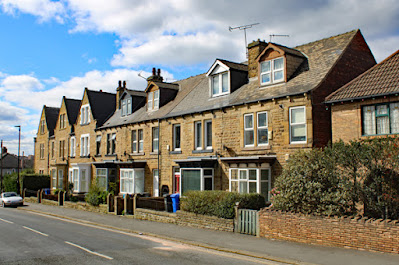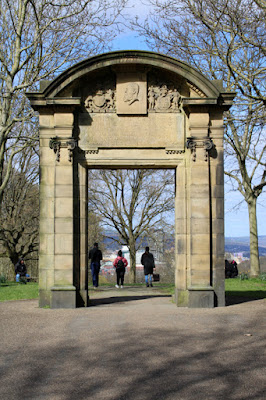 |
| The former arch to the refreshment pavilion in Norfolk Park |
After having a quick look at the Manor Board School, I headed off down St. Aidan’s Road on my way to Norfolk Heritage Park and immediately stopped to look at the masonry in a terrace of houses that had caught my eye the previous week, because the sandstone used in the houses looked similar to the stone used for the dressings in the school.
When briefly investigating the area around City Road and Norfolk Road, I encountered sandstone that had sporadic iron staining, which occasionally gave colour to part of the blocks of stone, and I have assumed that they came from a local quarry in the Silkstone Rock or Parkgate Rock; however, except for Gin Stables on Stafford Street, the only place where I have seen this general ‘ginger nut’ hue is in Handsworth – a distance of 3.5 km as the crow flies.
 |
| Artificial stone on St.Aidan's Road |
Continuing down the hill to the part of St. Aidan’s Road that is lined with interwar semi-detached houses, I was interested to see that, in addition to brick and occasionally stone, many of their front elevations are faced in artificial stone. As seen at St. Aidan’s church on City Road, this material was becoming popular at this time and it is also used for many of the boundary walls.
Arriving at the south-eastern St. Aidan’s entrance to Norfolk Heritage Park, I headed up to the Centre in the Park, which is built in uniformly buff coloured, medium grained gritstone ashlar. On this occasion, I think that this could be Crosland Hill stone from Huddersfield, because this stone was favoured during Phase 1 of the Heart of the City project in Sheffield – as I reported in StonePlus and Stein in Germany, for Tudor Square and Sheaf Square respectively.
Making my way to Arbourthorne Lodge, which doesn’t appear on the 1855 Ordnance Survey map and I assume was built at the same time as the screen wall at the Granville Road entrance to the park, in 1876, I again noticed orange sandstone blocks in the walling, with a massive gritty sandstone from the Millstone Grit used for the gateposts.
The 1855 map shows various quarries in the immediate vicinity, with Arbourthorne Quarry still being marked as being active on the 1906 map. This is located on the Silkstone Rock which, although described in the Geological Survey of Britain 1957 memoir as an indifferent building stone, is the probable source of the stone for the lodge.
I then had a quick look at the rear of Arbourthorne Cottages, dated to 1841 when the park opened, and again observed an abundance of orange coloured stone – for general walling and some lintels and other dressings.
The boundary wall to their yards; however, is built in an inferior quality sandstone, with laminated silty beds and blocks that are occasionally purplish in colour. This would seem to suggest that the stone is from one of the quarries that have exploited a sandstone found in the undifferentiated Pennine Lower Coal Measures Formation strata here.
In one location, the masonry of the yard wall to Arbourthorne Cottages South-West has a very reddened surface but, where the surface has weathered away, a grey interior of the blocks has been revealed. Although I have seen such a colour contrast occur when the iron in blue-hearted Coal Measures sandstone oxidises - as in the buildings of Handsworth and in Bowden Housteads Wood – I think that a fire may be responsible in this instance.
Returning to the main path through the park, I stopped to photograph the front elevations of the estate cottages. Although the park was sited downwind of the principal industrial areas, they have still been blackened by the industrial pollution, which contributed to George Orwell’s opinion that "Sheffield, I suppose, could justly claim to be called the ugliest town in the Old World…", when writing The Road to Wigan Pier in 1936.
Sheffield is a very different place today, with most of the iron and steel works and associated industries, which constantly belched coal smoke, having disappeared and from Norfolk Heritage Park, there are now clear views over the city.
I finished this leg of my walk by having a look at the ornate pedimented arch, which was originally the entrance to the refreshment pavilion, built in 1912 to commemorate the 12th Duke of Norfolk giving the park to the City of Sheffield.











No comments:
Post a Comment